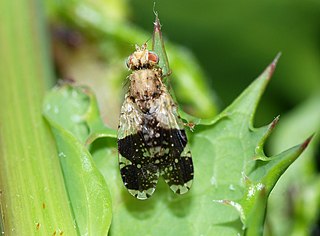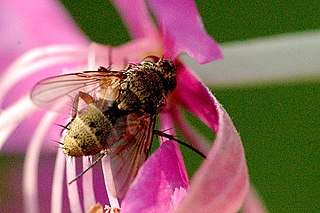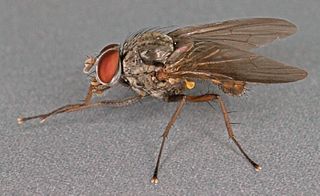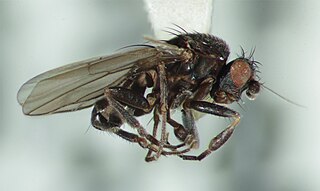
The Anthomyiidae are a large and diverse family of Muscoidea flies. Most look rather like small houseflies. Most species are drab grey to black. Many Pegomya are yellow, and some members of the genera Anthomyia and Eutrichota are patterned in black-and-white or black-and-silvery-grey. Most are difficult to identify, apart from a few groups such as the kelp flies that are conspicuous on beaches.

Pegomya is a genus of flies within the family Anthomyiidae. Some species are considered pests due to their leafmining larvae. Species include:
Actia maksymovi is a Palearctic species of fly in the family Tachinidae.
Actia dubitata is a Palearctic species of fly in the family Tachinidae.
Actia infantula is a Palearctic species of fly in the family Tachinidae.

Actia lamia is the type species of the genus Actia of the family Tachinidae.

Actia pilipennis is a Palearctic species of fly in the family Tachinidae.

Tephritis is a genus of flies. It contains around 170 described species, making it the sixth largest genus in the family Tephritidae. Many more undescribed species are known from specimen collections. Tephritis occur throughout much of the world, but most are Palearctic. They can be found in a wide range of climate types, from hot semidesert to tundra. Most species inhabit the inflorescences of plants from several tribes in the family Asteraceae, and a few species cause galls to form.

Orthonevra is a genus of fly in the syrphidae family with at least 59 species identified so far. They are worldwide in distribution but concentrated in the Eastern North America and Europe.Orthonevra are commonly called Mucksuckers after the larvae which have been found in organic rich mud, i.e. muck. This genus belongs to the tribe Brachyopini that includes the prominent genera Melanogaster, Brachyopa, Neoascia and Sphegina. Orthonevra have black heads with blue to purple reflections. Many species have distinctive eye stripes. The antennae are somewhat elongate. The frons is wrinkled with silvery spots at sides of antennae. The thorax with small punctures dorsally and in several species the body is covered with scale-like pile. Wingd vein M1 curves away from the wing tip.(see images)

Siphona (Ceranthia) lichtwardtiana is a species of tachinid flies in the subgenus Ceranthia of the family Tachinidae.

Siphona geniculata is a Palearctic species of fly in the family Tachinidae.

Pegomya winthemi is a species of fly in the family Anthomyiidae. Found in North America, it was first described as Anthomyia winthemi in 1829 by Johann Wilhelm Meigen. The insect measures 4.25–5 mm long. Its pedipalps are infuscated apically; the anterior lateral angles of the thorax and scutellum are yellowish red. The longest hairs of the arista are a little longer than its basal diameter, while the lower calyptra are distinctly protruded. The scutellum is almost bare on the disc. The posthumeral bristle is not duplicated, and the area between the posthumeral and the margin of thorax is almost bare.

Pegomya betae is a species of fly in the family Anthomyiidae. It is found in the Palearctic. For identification see

Pegomya bicolor is a species of fly in the family Anthomyiidae. It is found in the Palearctic. For identification see Host plants include Persicaria virginiana, Rumex acetosa, Rumex acetosella, Rumex conglomeratus, Rumex crispus, and Rumex obtusifolius.

Spelobia talparum is a species of fly belonging to the family of the Lesser Dung flies.

Spelobia palmata is a species of fly belonging to the family of the Lesser Dung flies.

Spelobia baezi is a species of fly belonging to the family of the Lesser Dung flies.
Chirosia flavipennis is a species of root-maggot flies in the family Anthomyiidae. It is a leaf miner of the host species Pteridium aquilinum.
Neoascia geniculata is a Palearctic species of hoverfly.

Biosteres is a genus of wasps belonging to the family Braconidae.















